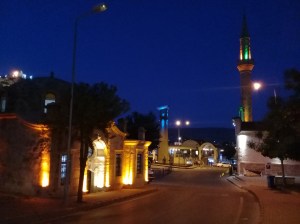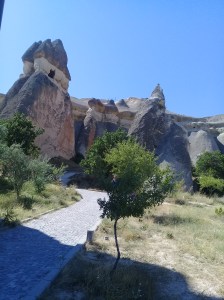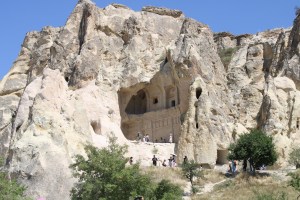After spending two hectic days in Istanbul it was time to move to Cappadocia. It was a comfortable 1 hour 35 minutes flight from Istanbul’s Sabiha Gokcen International Airport to Keyseri Airport by Turkish Airlines. Our stay in Cappadocia was in a small city called Urgup. It is capital of Cappadocia province. Urgup is about 50 kilometers from Keyseri Airport. The drive was about 1 hour 15 minutes from Keyseri Airport to our hotel in Urgup. The landscape on the way dry and mountainous somewhat like outskirts of Muscat. There is nothing of importance between the two cities.
Urgup is town in the historical region of Cappadocia. In Turkey it is also known as the town of the Librarian with Donkey. Mustafa Guzelgoz was a librarian in Urgup. He used to travel to nearby villages with books on donkeys to lend books so as to inculcate the habit of reading in the people. Hence the name “Librarian with Donkey”. Today Urgup is a major tourist town in Cappadocia and is known for its trademark cave hotels. There are cave hotels everywhere. It’s all related to geology. Millions of years ago there were active volcanoes in this region. The lava flow of the erupting volcanoes left porous stones called Tuff everywhere. Because these stones were not very hard, people started carving homes in them. Later on when people shifted to concrete houses some of these dwellings were converted into what are today called as cave hotels. Today Cappadocia is full of cave hotels. These are fitted with every possible luxury and very comfortable as well as naturally very cool. Today Cappadocia region is known for its cave hotels, fairy chimneys, hot air ballooning, pigeon holes and ancient underground cities. Some of early Christianity’s most important landmarks are in the region thus bringing in a lot of tourists.

Urgup City Bath is an Urgup Institution and Landmark. It is more than 100 years old family run Turkish Hamam near city center. Photo Credit & © Mohsin Aziz
We spent two days in Cappadocia. Our hotel in Cappadocia was Roca Cappadocia. It was a cave hotel. There was every modern facility inside the cave. The rooms were naturally cool and there was not need for Air Conditioning. The staff of the hotel was very polite. Most of the staff were female and used to call my wife as hurram (the word hurram is often prefixed with female names in Turkey as a sign of respect. It actually means ‘the cheerful one‘). Special thanks to Canan and Yasemin for taking good care of us.

The Courtyard of Roca Cappadocia boutique Cave Hotel. Photo Credit & © Mohsin Aziz

Exterior of our room at Roca Cappdocia. Photo Credit & ©Mohsin Aziz
Our tour operators in Cappadocia were HtR- Hit the Road. They were arranged by our main tour operator in Istanbul (True Blue Tour). I found them to be extremely professional with vehicles in top condition and excellent multilingual tour guides. First day our tour guide was Kezban. She was fluent in Spanish and English. Our group besides my family included two Spanish couples and one Singapore couple. As our guide explained every detail in both Spanish and English it gave us plenty of time to appreciate the finer points and take photographs. It was very relaxed tour and not rushed at all. Our first stop for the day was Rose Valley. Rose Valley is an isolated valley near Urgup. It is known for its rock formations with different colours. I was expecting to see lots of rose thinking that the valley must have got its name from presence of rose flowers. It is not so. The name is given because of presence pink and red colour rocks in the valley. We trekked the whole valley which must be anywhere between 3 to 4 kilometers. At many places we saw farms of grapes, apple and apricot. I also saw many almond trees but our guide told us that they were wild almonds and were poisonous.
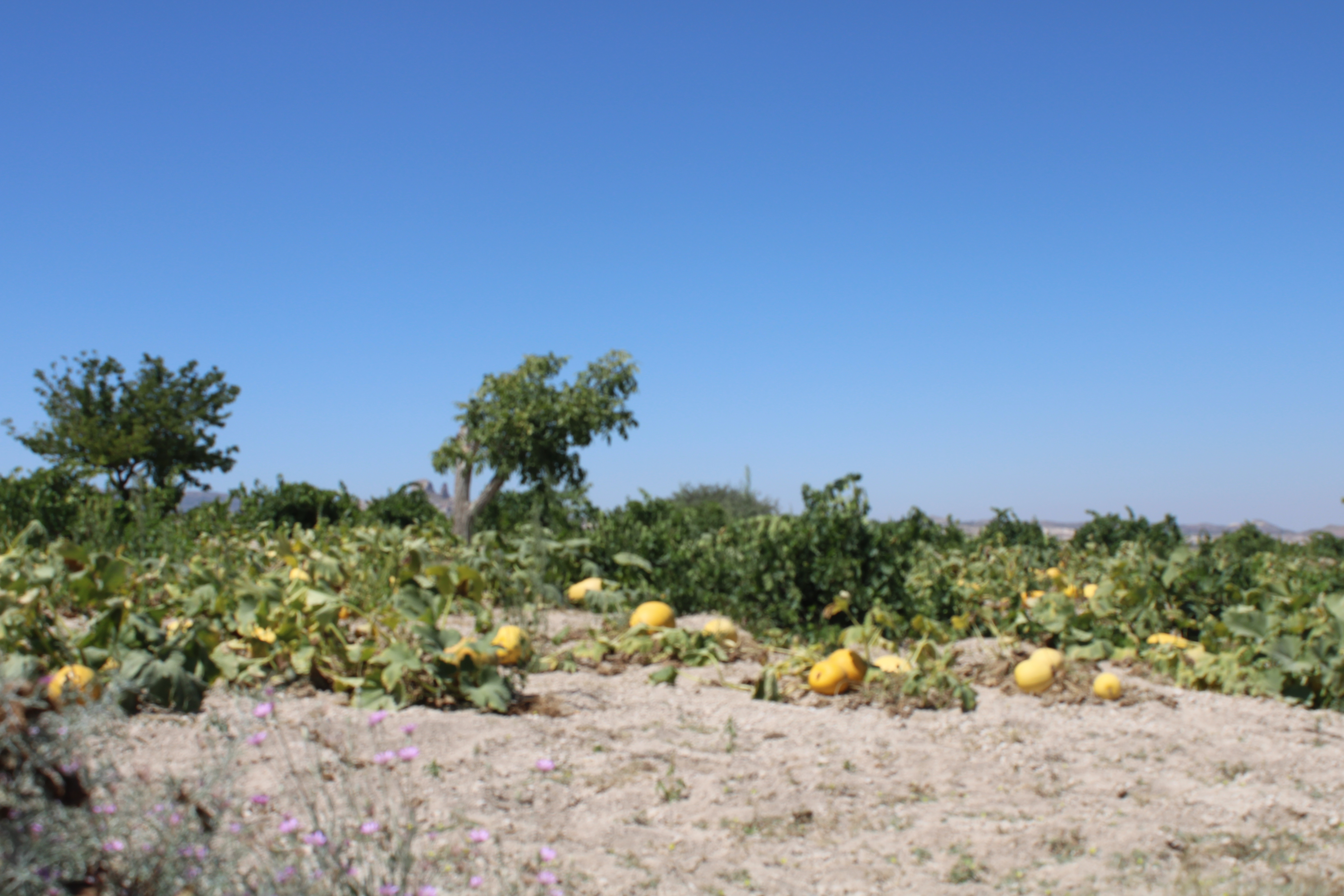
Sweet Melons along the track in Rose Valley. Photo Credit & © Mohsin Aziz

The road to nowhere. Our track in Rose Valley. Photo Credit & © Mohsin Aziz

A general view of Rose Valley. Hues of pink colour can be seen, hence the name. Photo Credit & © Mohsin Aziz
From Rose Valley the next stop was Devrent Valley near Cavusin Village (Pronounced as Kavushin). Unlike other valleys in this region, Devrent valley was never inhabited by humans. It is basically a group of rocks which have naturally got different animal looking shapes due to years of rain and wind. Just like shapes of clouds no two people agree what animal or shape a particular rock looks like. One can see rocks looking like double humped camel, dolphin or even a group of rocks looks like dancing dervishes. It is also called imagination valley. It’s fun for kids and even adults were acting like kids trying to identify and arguing among themselves whether a particular rock is shaped like a dolphin or something else?

A view of Cavusin village in Cappadocia. Photo Credit & © Mohsin Aziz.

Is it a double humped Camel or a Llama. Keep Imagining @ Devrent Valley a.k.a. Imagination Valley. Photo Credit & © Mohsin Aziz.
By the time we finished from imagination valley it was time for lunch. I was a bit apprehensive as to what type of lunch are we going to get in a small village restaurant. But to my surprise the restaurant was really huge. There must have been at least 200 people already dining and still our seats were reserved. The variety of food was amazing. Of all the places I never expected to see Shahi Tukda as one of the sweet dishes. I must have eaten at least four or five pieces of Shahi Tukda. I think after 4 kilometers of walk I deserved this.
Our next stop for the day was historical underground city of Kaymakli. Kaymakli is a UNESCO World Heritage Site. There are many underground cities in this region. Some have better defense system, some have more floors but Kaymakli is the largest one. Cappadocia lies on the silk route and other historically important trade routes hence various kings have tried to capture it. The present day Cappadocia has been at the center of some of the greatest civilizations and military power and their jostling for power. These cities are supposed to be built around 3000 B.C. during Hittites and Phrygians. The inhabitants of this place built whole cities under their houses and would go underground to escape the marauding armies whenever their was attack. Later on Assyrians, Akkadians, Romans, Seljuk’s, Iranians and Byzantines vied for power in the region until the Ottomans established their rule in the region. Early Christians during the 4th century used these cities to escape religious torture. It is estimated that around 3500 people once lived in Kaymakli. There is a maze nearly one hundred tunnels in the Kaymakli underground city. It has eight floors of which four are open to the tourists. The underground spaces are arranged around ventilation shafts so as to supply fresh air. Each floor used to serve a particular purpose. The first level was used as stable for animals. Another level was used as grain storage, winery and oil presser. One floor was used as living place. Another one has churches, chappels, graves, communal kitchen etc. We went up to four floors which are allowed for tourists. The path downwards is very steep. Although some people in our group came out from the first floor itself feeling claustrophobic. I went to the fourth floor underground and found it surprisingly well ventilated. Today these underground cities of Cappadocia are a must do for tourists to this region.

One of the underground tunnel at Kaymakli Underground City, Cappadocia. Photo Credit & © Mohsin Aziz.

Big Round Stone carved in Second Floor Underground. It was used as defense mechanism to close the tunnel in case of attack from outside. Photo Credit & © Mohsin Aziz
Second day in Cappadocia was Eid Al Adha. I had already found a mosque named Merkez Mustafa Aga Camii near to hotel and prayed Isha (last of the obligatory five prayers. Prayed around 1 and a half hours after sunset) so as to get an idea of the place. The Eid prayer was at 6.15 a.m. I reached the Mosque at 6.10 with a prayer mat which i had brought from Muscat anticipating huge rush at the Mosque. However i was surprised to find attendance at the Mosque to be thin and i found myself in the fourth row. I counted 68 people including myself and the Imam. There were very few youngster. Most of the people who gathered for Eid Prayer were elderly. The imam was dressed in trouser and shirt with tie thrown in for good measure. The first Khutba (Sermon) was in Turkish while the second was in Arabic. The prayer was short. It was a unique experience for me. Just opposite the Mosque is a Urgup Landmark. Its Urgup Baths which is a traditional family run Turkish Hamam.

Merkez Mustafa Aga Camii Mosque where I prayed Eid Al Adha on 11 August, 2019. Photo Credit & © Mohsin Aziz.
In fact second was supposed to begin very early as we booked hot air balloon ride for that day expecting the Eid to one the previous day. However, when the Eid was not on first day, i got my ride cancelled as hot air balloons fly only early morning. Next day we found out that anyway all the balloon rides that day were cancelled due to unfavorable wind conditions.
Our guide for second day in Cappadocia was Mr. Murat. He was also multilingual and besides Turkish was fluent in English and Spanish. Group members were same as previous day.
Our first stop on second day was Goreme Open Air Museum (pronounced as Goreymey). It is outside Goreme city. The region is known for fairy chimneys. Fairy chimneys are naturally carved out rock formations. They change colour at the sunset. As I have mentioned somewhere, this was active volcanic region. The lava and ash which erupted millions of years ago blanketed the whole region in thick ash. With passage of time this ash solidified as soft rock and is called Tuff. With the natural elements like rain and wind striking them for millions of years, the softer parts were eroded away and only the harder parts remained. This process resulted in extraordinary rock shapes which go up to more than 130 feet high and are called fairy chimneys. When early Christians were persecuted by Romans, they fled to this region and realised that living quarters can be carved out of the soft rocks. They assembled in Goreme and carved not only living quarters high up in the rocks for themselves but also carved out innumerable churches. Goreme is perhaps the biggest collection of such churches at one place in Cappadocia. Christian monks built a maze of interconnected living quarters, stables, grain storage facilities besides churches. They also built individual prayer chambers high up in the rocks with steps carved out of the rock itself. Today Goreme Open Air Museum is a huge open air enclosure which is a UNESCO World Heritage Site. It is visited by tourists from all over the world. It is particular high up in the order of Turkey’s religious tourism ladder and is almost a must see attraction for tourists on Christianity trial in Turkey.
The churches in the Goreme Open Air Museum are also known for well preserved Fresco Art which has survived the test of time. One of the most important churches with Red couloured Fresco paintings is the Dark Church.
Some of the older cave dwellings have also been converted into luxury boutique hotels thus providing opportunity to tourists to partly experience the life inside rocks.

Fresco Paintings can be seen in this close up picture of the outside part of the Dark Church at Goreme Open Air Museum. Photo Credit & © Mohsin Aziz
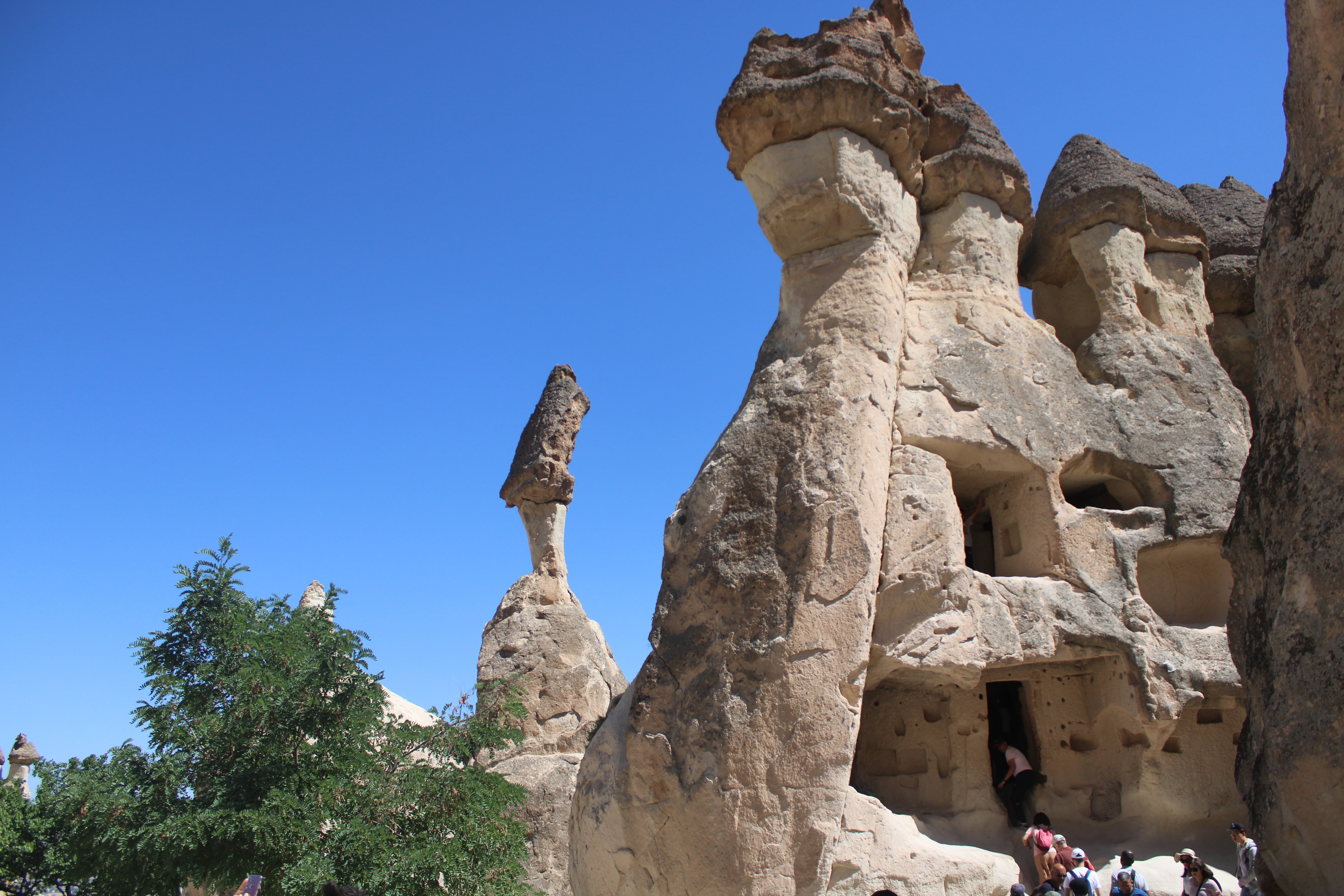
Residences of Monks at Goreme Open Air Museum. Photo Credit& © Mohsin Aziz.
We spent around two and half an hours at Goreme Open Air Museum. It was time to move to our next destination. Before leaving the complex we went to Museum Shop at the exit and had some snacks and tea at the Museum Shop Restaurant. Our next destination was a Small Village called Avanos in Cappadocia. Its an old village which was called Venessa in old times. It is along river Kizilirmak which is also called Red River. Red River is the longest river of Turkey. It is popularly called Red River because it carries red silt with it and deposits on its banks. Avanos is also known as pottery town of Turkey. The red silt deposited by Kizilirmak river has been used since the times of Hittites to make pottery by the people of the town. The red silt in river side mud gives a unique texture to the ceramics produced here. Today the village is dominated by numerous pottery making factories. Pottery is made using traditional method. Ceramics produced here are not only sold all over Turkey but are exported all over the world. To make the visit more interesting we were given a live demonstration of pottery making at a local factory. We were shown the different stages of pottery making up to the last step of hand painting of ceramics. We saw workers hand painting various designs on ceramics before they were put on display or were packed to be transported all over Turkey. For bigger pottery and ceramic items, most of the workshops have courier facility to all over the world.

River Kizilirmak (Red River) flowing through the village of Avanos. Photo Credit & © Mohsin Aziz.
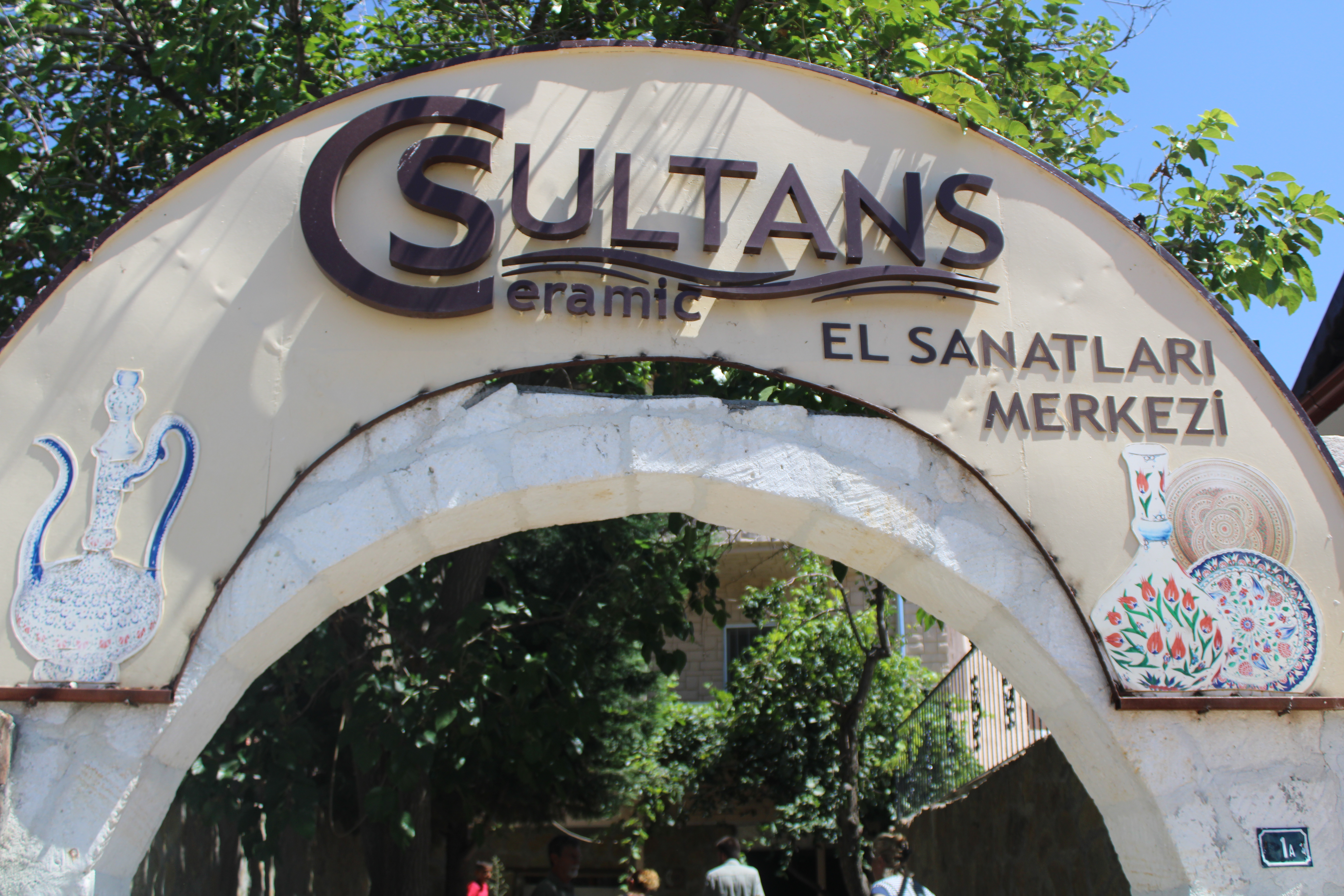
Sultans Ceramic where we saw a pottery making session and bought some ceramics as souvenir’s. Photo Credit & © Mohsin Aziz

Ceramics on display at Sultans Ceramics, Avanos. Photo Credit & © Mohsin Aziz.
After enjoying our visit to the ceramic workshop it was time for lunch. We were taken to a restaurant next to river river. I don’t remember the name of the restaurant but it was food at the restaurant was the best Turkish food that we had in our entire stay in Turkey. It was a small but very modern restaurant. After lunch was our drive back to our hotel in Urgup. Tonight was our flight back to Istanbul. On the way back to hotel we passed through Pasabag monks valley and also saw the pigeon valley. Pasabag valley contains some of the most striking examples of fairly chimneys some of them having two or some cases even three caps. Since they look like mushrooms they are also called mushroom chimneys.

An Aerial view of the Pasabag Valley. Photo Credit & © Mohsin Aziz.

Monks chamber up in the rock can be seen in Pasabag Monks Valley. Steps cut in rock can be seen leading up to the chamber. Photo Credit & © Mohsin Aziz.

Moonscape can be seen on the way back to hotel in Urgup from Avanos Village. Photo Credit & © Mohsin Aziz.

Fairy Chimney with chamber for Monks Meditation in Pasabag Monks Valley. This Fairy Chimney has three caps at the top. Photo Credit & © Mohsin Aziz.
The hermits of Cappadocia in ancient times used to lead reclusive life. In order to be away from the masses so that they can meditate and contemplate they used to live in these chambers which they carved 10 to 15 meters up in the Tuffs. They used to get down for food and would go back in their chambers. On the way we also passed through what is called as Guvercinlik Vadisipigeon valley (pigeon valley). It has got its name from the innumerable dovecotes that have been carved at height in the fairy chimneys. Although such dovecotes are found in the whole of Cappadocia, they are nowhere as numerous as pigeon valley, hence the name. In old times, these dovecots were carved to attract pigeons to sit in them. Over period of time their droppings got collected and were taken down by the farmers to fertilize their barren lands. Though pigeons don’t play important role in modern agriculture now, still many dovecotes have been maintained by the people in the Cappadocia region.
On the way back we also passed by Uchisar Castle and saw it only from outside. Uchisar Castle was used as a defense mechanism in the past against invasion. As it is the highest point in Cappadocia, the Castle provided vantage point to keep an eye on the whole region. In the past it was on the busy and vital silk route. At present Uchisar Castle is a UNESCO World Heritage Site. However, nobody in our group had energy to climb up to see the place. Everybody just took pictures from below and we moved on to a small bazaar (market) with some restaurants and lots of souvenir shops. Most of the shops were selling either different varieties of scarf or Nazar (evil eye) amulets. Evil eye beads or Nazar Boncuk is a glass bead usually of blue colour and filled with a blue or black dot superimposed on a white center in the form of a tear drop. Nazar Boncuk are quite popular in Turkey. When I inquired about them from Murat he categorically stated that it has nothing to do with Islam and is only a cultural thing. Still i was surprised to see so many Evil Eye Beads being sold everywhere in Turkey.

Dove Cots can be seen in this Fairy Chimney at the Pigeon Valley. Photo Credit & © Mohsin Aziz
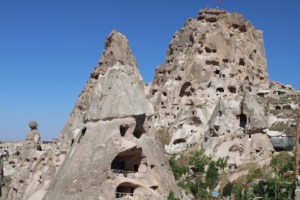
Uchisar Castle atop a rock on the way to Hotel. Photo Credit & © Mohsin Aziz.

Souvenir Shop selling Nazar Boncuk (Evil Eye Bead) near Uchisar. Photo Credit & & © Mohsin Aziz
By the time we reached hotel it was time for dinner. We decided to take dinner at Urgup market. We found a nice hotel named Urgup Restaurant near city square. It was usual Turkish fare and i ordered a few items. However, the old owner of the restaurant came to us and insisted that we try Adana Kebapi. Also called Kiyma Kebabi, it is made from hand minced meat of only male lamb. Mincemeat is hand mixed with lamb tail fat and charcoal grilled on iron skewers. It is served with coal charred peppers and tomato. It’s named after fifth biggest Turkish city of Adana. On his insistence, Adana Kebapi was ordered and boy did i regret ordering it? Not at all. it was worth every lira spent on it. It was the best Kebap in my entire Turkey Tour. What a nice way to end our day and tour of Cappadocia. We returned to hotel as tonight we had to fly to the coastal city of Kusadasi in Izmir province. Thus ended our two absolutely wonderful days in Magical Cappadocia.
